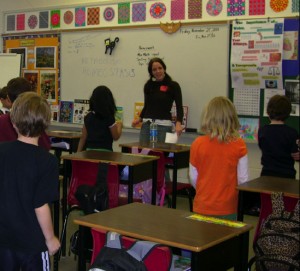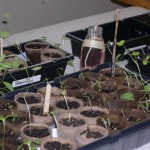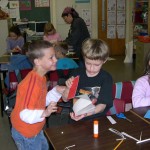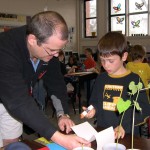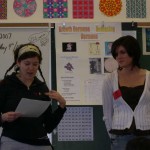MSH
October 6, 2011 in Peptide
Wednesday, May 30th, 2007, Halifax, NS, 2nd graders blocked the sun and shouted MSH (mush), MSH, MSH … as the team of Jeff Farrell (BSc, SMU) and Valerie Walker (MFA graduate ’07, NSCADU) illuminated them about Melanocyte Stimulating Hormone, the peptide responsible for suntans and freckles. Provided pictures about pigmentation, peptides and prevention of sunburn, the students discussed the advantages of animals that change their color, sunscreen and melanin, as they constructed a collage about MSH. Pouring bicarbonate into cherry juice to turn it black, and returning the juice to red with the action of lemon juice, Jeff showed that just as light can change our skin color by stimulating the production of MSH in the brain, other changes in environment, such as the effects of pH, can also cause color changes. Exposing all to some sunshine fun, Valerie enlightened us with the art of sun printing fabric paint as we made MSH-inspired bandanas. As MSH causes skin cells to use pigments called melanin for sun protection, the students cut shapes of things that block the sun (trees, umbrellas, hats, etc.), painted landscapes with the fabric paint on cloth, applied the shapes as stencils to the cloth to block the suns effects, and awaited the photochemical changes, while sharing in the fun of cleaning up. Looking forward to using their bandanas to block the sun this summer, all cherished exposure to some peptides and sunshine, learning about the body’s painter of pigmentation, Melanocyte Stimulating Hormone.
Team MSH, Jeff Farrell (BSc, SMU) and Valerie Walker (MFA graduate ’07, NSCADU) signing “M” for MSH, in front of their class made collage about Melanocyte Stimulating Hormone.
Jeff making cherry juice return to red with lemon juice, one of those acids we can eat.
Valerie enlightening students in the art of sun printing fabric paint.
A moment of MLP bliss, painting, cutting out stencils and thinking about peptides.
Wetting down the stencils on the fabric paint.
The 2nd graders interpret the curved bio-active conformation of MSH in appreciation of MLP sunshine.


